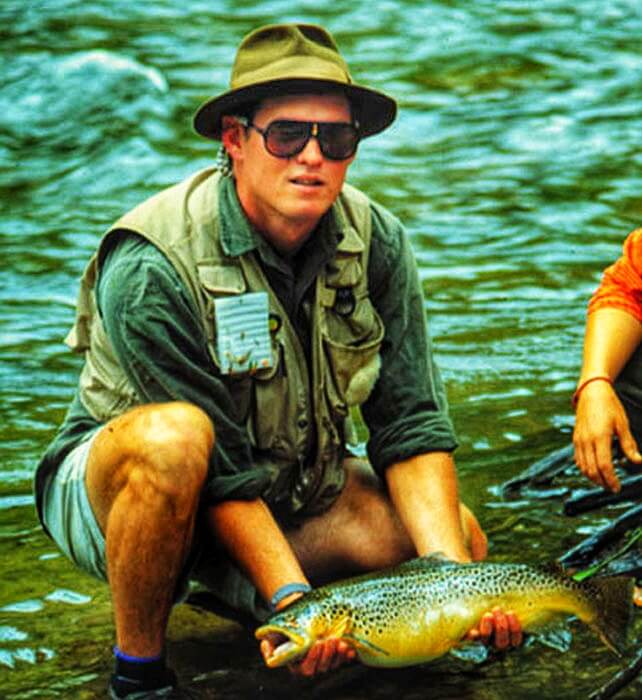Thoughts on articulated sculpin patterns
Articulated sculpin patterns depend largely on conditions and water types. I prefer tying articulated Sculpin patterns in olive, brown, and black. The pic above is of a Brown trout caught on the lower Nantahala River on a Sculpin pattern in 1988. Some great new patterns available today with the use of specialized hinges from companies like Flymen. The Fish Skull heads make adding the weight a cinch for realistic sculpin heads. The materials today also offer the fly tier so many choices with UV colors, action, and weight when putting streamers together on the vise. Kelly Galloup has many very productive streamers that take advantage of using these materials.
Had a blast discussing pattern triggers, materials, tactics until the late hours when he was here in the fall. Big flies consistently tend to produce more quality big fish. This last summer was no exception on the Nantahala River with its fantastic wild brown population. The show “Big Mac Browns” will air first on 2/14/2011 (FFTV on Versus) which has footage of Kelly’s visit here to Western NC. The past few years have had me playing around with foam butts and heavy front hook sections to emulate feeding Sculpins that try to burrow in amongst bottom structure. Here is a pic of one that is in black that sinks heavy in the front and the rear action undulates up and down.
The Wire Attachment for Articulation
The articulation is on 20lb. wire with 2 beads very close to the front hook. The wire must run up /down for the two sections or there will be trouble with the action (in other words when you fold it through the back hook keep the top on top and the bottom on the bottom). You can find braided stainless wire from craft stores like Michaels. Other ingredients include Black wool; Black marabou; Black craft fur; Olive sparkle chenille for underbody; Foam in the rear hook; Lead and tungsten in the front section; Doll eyes on the wool head in front.
Now the other thing that causes this to trigger strikes is the profile once it is wet. Lots of action on the back section which tapers nicely when wet (mostly marabou). The front section creates a bigger profile with the use of craft fur, then marabou, and the thick head of black wool. This is the type of pattern that I use for flirting with really large trout on my home waters on rivers like the Nantahala. articulated sculpin patterns
Single Hook Streamer
This last pic is an olive Sculpin tied on a 4XL number 2 streamer hook. It uses an olive rabbit strip with a black sharpie to put the stripes on it. Another feature of this fly is the grouse shoulder feathers treated with Clear Cure Goo to provide flexible stiffness. This assists in a wobble action and moves lots of water for a big acoustic footprint. Lots of lead and tungsten for riding the bottom structure (72 grains). It uses olive sparkle chenille, olive marabou in the tail, dyed olive barred rock wrapped over the chenille. The olive wool head built up bulky in the front section.
A general rule of thumb is that when it is really bright out and water is clear, get your streamers near the bottom of the river for the best results. You can build custom lines that make this an easy affair by splicing the Streamer Express line choices from Scientific Anglers to a thin floating line which makes a fast sinking line. It is not uncommon for me to throw 300 to 400 grains of sink tip on the Nantahala River when the water is on due to generation. Sculpins are bottom dwellers so most of the tie I use heavy sinking lines to fish them on high water.
Whenever light conditions are low like overcast days and dirty water the best results tend to come by fishing darker flies nearer to the surface. These are usually attractors that represent baitfish other than sculpin. Use a clear slow sinking intermediate line for stealth reasons. Happy stripping and tight lines!

